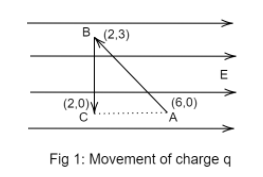
A test charge is moved without acceleration from A to C along the path from A to B and then from B to C in electric field E as shown in the figure.
(i) Calculate the potential difference between A and C.
(ii) At which point of the two is the electric potential more and why?


Answer
505.1k+ views
Hint:
1. The potential difference doesn’t depend on the path taken to displace a charge from one point to another. Electric potential is produced by a conservative electric field. In any conservative field, only starting and endpoints matter to define potential not the path.
2. In the direction of the field, a point that is nearer to the source or located earlier along the field lines generally has a higher potential than other.
Formula used:
1. Two-point distance formula in 2D:\[d = \sqrt {{{({x_{final}} - {x_{initial}})}^2} + {{({y_{final}} - {y_{initial}})}^2}} \]
Where, $d$ is the distance between two points
And
2. Electric field
$E = \dfrac{{ - dV}}{{dx}}$ ……(1)
where,
$V$ is the potential.
$x$ is the displacement.
Complete step by step solution:
Given:
The charge is displaced as in fig 1.
Electric field = $E$
We need to find the potential difference between $A$ and $C$.
(i) Find the displacement of the charge:
Distance between point $A$ and $C = 2 - 6$
Distance between point $A$ and $C = -4$
Rearrange eq (1) to get:
$Edx = - dV$
Integrate for the total displacement of the charge. As the potential doesn’t depend on the path taken, we can take the limits as ${V_A}$ and ${V_C}$:
\[\int\limits_0^x {Edx} = - \int\limits_{{V_A}}^{{V_C}} {dV} \]
Put $x = - 4$as the displacement from A to C:
$\Rightarrow E( - 4 - 0) = - ({V_C} - {V_A})$
$\Rightarrow {V_C} - {V_A} = 4E $
(ii) We have seen in (i) that ${V_C} - {V_A}$ is a positive quantity. This implies that ${V_C} > {V_A}$.
$\therefore$ (i) The potential difference between $A$ and $C$ is $4E$.
(ii) The potential at point $C$ is more than the potential at point $A$.
Note:
In questions like these, apply the right-hand thumb rule to find the direction of the induced magnetic field. Then apply Lenz’s law to find the induced current generated in the rings to oppose it.
1. The potential difference doesn’t depend on the path taken to displace a charge from one point to another. Electric potential is produced by a conservative electric field. In any conservative field, only starting and endpoints matter to define potential not the path.
2. In the direction of the field, a point that is nearer to the source or located earlier along the field lines generally has a higher potential than other.
Formula used:
1. Two-point distance formula in 2D:\[d = \sqrt {{{({x_{final}} - {x_{initial}})}^2} + {{({y_{final}} - {y_{initial}})}^2}} \]
Where, $d$ is the distance between two points
And
2. Electric field
$E = \dfrac{{ - dV}}{{dx}}$ ……(1)
where,
$V$ is the potential.
$x$ is the displacement.
Complete step by step solution:
Given:
The charge is displaced as in fig 1.
Electric field = $E$
We need to find the potential difference between $A$ and $C$.
(i) Find the displacement of the charge:
Distance between point $A$ and $C = 2 - 6$
Distance between point $A$ and $C = -4$
Rearrange eq (1) to get:
$Edx = - dV$
Integrate for the total displacement of the charge. As the potential doesn’t depend on the path taken, we can take the limits as ${V_A}$ and ${V_C}$:
\[\int\limits_0^x {Edx} = - \int\limits_{{V_A}}^{{V_C}} {dV} \]
Put $x = - 4$as the displacement from A to C:
$\Rightarrow E( - 4 - 0) = - ({V_C} - {V_A})$
$\Rightarrow {V_C} - {V_A} = 4E $
(ii) We have seen in (i) that ${V_C} - {V_A}$ is a positive quantity. This implies that ${V_C} > {V_A}$.
$\therefore$ (i) The potential difference between $A$ and $C$ is $4E$.
(ii) The potential at point $C$ is more than the potential at point $A$.
Note:
In questions like these, apply the right-hand thumb rule to find the direction of the induced magnetic field. Then apply Lenz’s law to find the induced current generated in the rings to oppose it.
Recently Updated Pages
Master Class 12 Business Studies: Engaging Questions & Answers for Success

Master Class 12 Social Science: Engaging Questions & Answers for Success

Master Class 12 English: Engaging Questions & Answers for Success

Master Class 12 Chemistry: Engaging Questions & Answers for Success

Class 12 Question and Answer - Your Ultimate Solutions Guide

Master Class 12 Economics: Engaging Questions & Answers for Success

Trending doubts
What are the major means of transport Explain each class 12 social science CBSE

Which are the Top 10 Largest Countries of the World?

Draw a labelled sketch of the human eye class 12 physics CBSE

How much time does it take to bleed after eating p class 12 biology CBSE

Explain sex determination in humans with line diag class 12 biology CBSE

Differentiate between homogeneous and heterogeneous class 12 chemistry CBSE




